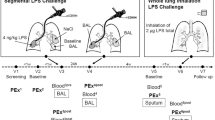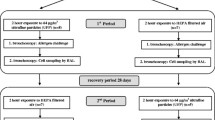Abstract
Inhaling bacterial endotoxin and its derivative LPS can induce a distinct inflammatory response, varying among hosts. Experimental LPS-inhalation is an established procedure in inflammation research. We evaluated experimental LPS-inhalation in 20 young healthy volunteers to determine the safety and the reproducibility of markers of inflammation and clinical findings (symptoms, lung function, exhalative NO, and body temperature). LPS was increased every 30 min up to cumulative 100 μg, the protocol was repeated after 2, 4, and 6 weeks. During 71 provocations, 13 episodes of clinical complaints were observed in 10 subjects. Those were a total of 11 local reactions (15.5%, e.g., cough), and six systemic reactions (8.5%, e.g., fatigue). All adverse events resolved spontaneously within 10 h. Changes of FEV1 and eNO showed no significant differences between the four visits. In the majority of our subjects (88.2% on visit 1–3, 76.5% on visit 4), a rise in body temperature (>0.5°C) was recorded and normalised latest after 24 h. On the first and the last visit, serum concentrations of CrP and LBP increased significantly and correlated well with each other (r = 0.71; P < 0.001). LPS-challenge is a safe and tolerable tool to investigate inflammatory response in humans and could lead to better characterization of patients with chronic inflammatory disease.




Similar content being viewed by others
Abbreviations
- LPS:
-
Lipopolysaccharide
- LBP:
-
Lipopolysaccharide binding protein
- FEV1 :
-
Forced expiratory volume within one second
- eNO:
-
exhaled nitric oxide
References
Ahmed N, Thorley R, Xia SY, Samols D, Webster RO (1996) Transgenic mice expressing rabbit C-reactive protein exhibit diminished chemotactic factor-induced alveolitis. Am J Respir Crit Care Med 153:1141–1147
Alexis N, Elridge M, Reed W, Bromberg P, Peden DB (2001) CD14-dependent airway neutrophil response to inhaled LPS: role of atopy. J Allergy Clin Immunol 107:31–35
American Thoracic Society (1999) Recommendations for standardized procedures for the online and offline measurements of exhaled lower respiratory nitric oxide and nasal oxide in adults and children. Am J Resp Crit Care Med 160:2104–2117
Bland JM, Altoona DG (1986) Statistical methods for assessing agreement between two methods of clinical measurements. Lancet 1:307–310
Brass DM, Savov JD, Whitehead GS, Maxwell AB, Schwartz DA (2004) LPS binding protein is important in the airway response to inhaled endotoxin. J Allergy Clin Immunol 114:586–592
Fan MH, Klein RD, Steinstraesser L, Merry AC, Nemzek JA et al (2002) An essential role for lipopolysaccharide-binding protein in pulmonary innate immune responses. Shock 18:248–254
Fearon DT, Locksley RM (1996) The instructive role of innate immunity in the acquired immune response. Science 272:50–53
Jack RS, Fan X, Bernheiden M, Rune G, Ehlers M, Weber A, Kirsch G, Mentel R, Furll B, Freudenberg M et al (1997) Lipopolysaccharide-binding protein is required to combat a murine gram-negative bacterial infection. Nature 389:742–745
Jagielo PJ, Thorne PS, Watt JL, Frees KL, Quinn TJ et al (1996) Grain dust and endotoxin inhalation challenges produce similar inflammatory responses in normal subjects. Chest 110:263–270
Kitz R, Rose MA, Borgmann A, Schubert R, Zielen S (2006) Systemic and bronchial inflammation following LPS inhalation in asthmatic and healthy subjects. J Endotox Res 12(6):368–374
Kline JN, Cowden JD, Hunninghake GW, Schutte BC, Watt JL et al (1999) Variable airway responsiveness to inhaled lipopolysaccharide. Am J Respir Crit Care Med 160:297–303
Knapp S, de Vos AF, Florquin S, Golenbock DT, van der Poll T (2003) Lipopolysaccharide binding protein is an essential component of the innate immune response to Escherichia coli peritonitis in mice. Infect Immun 71:6747–6753
Larsson KA, Eklund AG, Hansson LO, Isaksson BM, Malmberg PO (1994) Swine dust causes intense airways inflammation in healthy subjects. Am J Respir Crit Care Med 150:973–977
Mattsby I, Rylander R (1978) Clinical and immunological findings in workers exposed to sewage dust. J Occup Med 20:690–692
Medzhitov R, Janeway CA Jr (1997) Innate immunity: impact on the adaptive immune response. Curr Opin Immunol 9:4–9
Michel O, Dentener M, Corazza F, Buurman W, Rylander R (2001) Healthy subjects express differences in clinical responses to inhaled lipopolysaccharide that are related with inflammation and with atopy. J Allergy Clin Immunol 107(5):797–804
Michel O, Ginanni, Sergysels R (1992) Relation between the bronchial obstructive response to inhaled lipopolysaccharide and bronchial responsiveness to histamine. Thorax 47:288–291
Michel O, Kips J, Duchateau J, Vertongen F, Robert L et al (1996) Severity of asthma is related to endotoxin in house dust. Am J Respir Crit Care Med 154(6):1641–1646
Michel O, Nagy AM, Schroeven M, Duchateau J, Nève J et al (1997) Dose-response relationship to inhaled endotoxin in normal subjects. Am J Respir Crit Care Med 156:1157–1164
Michel O, Duchateau J, Plat G, Cantinieaux B, Hotimsky A et al (1995) Blood inflammatory response to inhaled endotoxin in normal subjects. Clin Exp Allergy 25:73–79
Nightingale JA, Rogers DF, Hart LA, Kharitonov SA, Chung KF et al (1998) Effect of inhaled endotoxin on induced sputum in normal, atopic, and atopic asthmatic subjects. Thorax 53:563–571
Rylander R, Bake B, Fischer JJ, Helander IM (1989) Pulmonary function and symptoms after inhalation of endotoxin. Am Rev Resp Dis 140:981–986
Schmitt-Grohé S, Hippe V, Igel M, von Bergmann K, Zielen S et al (2005) Lipopolysaccharide binding protein, cytokine production in whole blood, and lipoproteins in cystic fibrosis. Pediatr Res 58(5):903–907
Sundy JS, Wood WA, Watt JL, Kline JN, Schwartz DA (2006) Safety of incremental inhale lipopolysaccharide challenge in humans. J Endotox Res 12(2):113–119
Thorn J, Rylander R (1998) Inflammatory response after inhalation of bacterial endotoxin assessed by the induced sputum technique. Thorax 53:1047–1052
Wright SD, Ramos RA, Tobias PS, Ulevitch RJ, Mathison JC (1990) CD14, a receptor for complexes of lipopolysaccharide (LPS) and LPS binding protein. Science 249:1431–1433
Zweigner J, Gramm HJ, Singer OC, Wegscheider K, Schumann RR (2001) High concentrations of lipopolysaccharide-binding protein in serum of patients with severe sepsis or septic shock inhibit the lipopolysaccharide response in human monocytes. Blood 98:3800–3808
Acknowledgments
Competing interests: no financial or non-financial interests
Author information
Authors and Affiliations
Corresponding author
Additional information
Richard Kitz and Markus A. Rose contributed equally and should therefore, be considered as first authors.
Rights and permissions
About this article
Cite this article
Kitz, R., Rose, M.A., Placzek, K. et al. LPS inhalation challenge: a new tool to characterize the inflammatory response in humans. Med Microbiol Immunol 197, 13–19 (2008). https://doi.org/10.1007/s00430-007-0053-2
Received:
Published:
Issue Date:
DOI: https://doi.org/10.1007/s00430-007-0053-2




